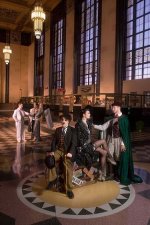jano
Evil Bokeh
Hey, this is way OT and probably akin to heresay since most of us are fans of natural light (especially me). But I decided to play around a bit with my dslr to learn something about flash photography -- and because I really wanted something to do besides watch tv on saturday and sunday night 🙂
So here goes: I ran some tests to understand flash exposure. Four variables: iso, flash power, aperture, and shutter speed. I ran three tests. First fixed iso and flash power, second fixed iso and shutter speed, and third fixed iso and aperture. The remaining elements in each test were adjusted to allow for proper exposure.
The first test had expected results. When I closed up the aperture one stop, I decreased shutter speed one stop -- as I went from f4 to f16 my shutter went from 1/15" to 1", and I could see how ambient light took over the effect of the flash.
The second test I wasn't quite sure what to expect. As I increased the power output of the flash (1/16, 1/8, 1/4, 1/2, and full), I closed down the aperture. My thought was that ambient might take over because the shutter became longer relativley speaking (although it stayed the same length). However.. what actually happened was that the flash became more pronounced, pulling out the ambient. I guess this makes sense because I was simply letting in less of the ambient light.
Third test.. boy am I confused. When I doubled the power from 1/16 to 1/8, I increased my shutter by one stop from 1/15" to 1/30" while keeping aperture constant. Same idea as before. But the result? A flash blasted picture that was well overexposed. I had to drop the shutter one more stop (1/60") to get the right exposure. Then when I doubled the flash again to 1/4 power, I had to actually increase the shutter by a total of four stops from the original 1/15" to 1/250". Going to 1/2 and full power was not possible without closing down aperture, and or dropping the iso, since my sync speed is 1/200! I had to go 7 stops under exposed to get 1/2 power flash with good exposure.
So.. any idea what's going on? Does this make sense? Doesn't to me 🙁
So here goes: I ran some tests to understand flash exposure. Four variables: iso, flash power, aperture, and shutter speed. I ran three tests. First fixed iso and flash power, second fixed iso and shutter speed, and third fixed iso and aperture. The remaining elements in each test were adjusted to allow for proper exposure.
The first test had expected results. When I closed up the aperture one stop, I decreased shutter speed one stop -- as I went from f4 to f16 my shutter went from 1/15" to 1", and I could see how ambient light took over the effect of the flash.
The second test I wasn't quite sure what to expect. As I increased the power output of the flash (1/16, 1/8, 1/4, 1/2, and full), I closed down the aperture. My thought was that ambient might take over because the shutter became longer relativley speaking (although it stayed the same length). However.. what actually happened was that the flash became more pronounced, pulling out the ambient. I guess this makes sense because I was simply letting in less of the ambient light.
Third test.. boy am I confused. When I doubled the power from 1/16 to 1/8, I increased my shutter by one stop from 1/15" to 1/30" while keeping aperture constant. Same idea as before. But the result? A flash blasted picture that was well overexposed. I had to drop the shutter one more stop (1/60") to get the right exposure. Then when I doubled the flash again to 1/4 power, I had to actually increase the shutter by a total of four stops from the original 1/15" to 1/250". Going to 1/2 and full power was not possible without closing down aperture, and or dropping the iso, since my sync speed is 1/200! I had to go 7 stops under exposed to get 1/2 power flash with good exposure.
So.. any idea what's going on? Does this make sense? Doesn't to me 🙁


